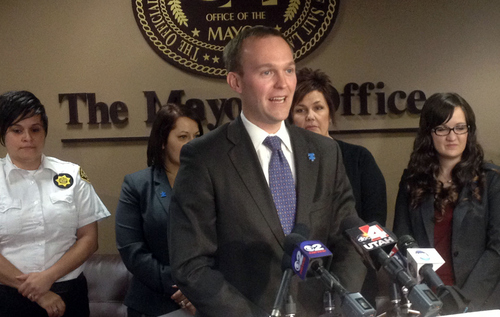This is an archived article that was published on sltrib.com in 2014, and information in the article may be outdated. It is provided only for personal research purposes and may not be reprinted.
It was like giving birth, Sen. Karen Mayne said of the nine months she spent crafting a bill that could help resolve 40 years of unproductive political squabbling over municipal boundaries within Salt Lake County.
"And now we have a beautiful baby to show for it," the West Valley City Democrat said Friday as she unveiled a third revision of SB216, which Salt Lake County Mayor Ben McAdams pulled together in lengthy negotiations this week.
This latest version was comely enough that both supporters and opponents of the contentious Millcreek City debate endorsed it when McAdams and Mayne announced at a news conference that a compromise had been reached.
That solidarity held sway minutes later when the Senate passed the measure on to the House on a 27-0 vote.
If approved there and signed by the governor, the bill essentially would amount to "pressing the pause button," McAdams said.
As it has all along, SB216 would freeze the boundaries of the unincorporated-area townships where they are now until Nov. 15, 2015, an exception being made for an effort already underway to annex the Olympus Hills subdivision into Holladay.
But rather than seeking to allow non-contiguous, unincorporated communities to become a city, the legislation lays out a process for the county and community leaders to create a municipal-services district.
Over the next year, this process will evaluate how services can still be delivered to this far-flung collection of communities — Kearns and Magna, Copperton and White City, Millcreek and Emigration Canyon — taking advantage of the county's existing economies of scale.
Going this route conceivably allows Millcreek residents to reactivate their incorporation drive, with an eye on getting the measure on the ballot as early as November of 2015, or 2016 at the latest.
If passed, the new city could still remain in the municipal-services district even while gaining independence and electing its own slate of close-to-home, local government leaders.
"I am not going to stand in the way of local citizens making decisions," McAdams said, adding that freezing township boundaries where they are "enables conversations to continue without flare-ups and cherry picking."
He praised the community leaders for being flexible in their negotiations. "They have chosen to let go of fears and grudges that may have defined conversations in the past," the mayor said, "recognizing that contention is more harmful than compromise."
That's true, said Hugh Matheson, representing Millcreek City supporters. "[McAdams] decided we should talk, not bicker. You get better public policy when you talk," he added, saying this new approach resolves a "structural problem" in unincorporated-area governance.
It also establishes a "procedure that makes sense" for getting incorporation onto the ballot," Matheson said.
Roger Dudley, a foe of making Millcreek a city, said he believes this approach will work because it protects the status quo while leading the different parties "to the point where we can discuss, on friendly terms, what's right for our communities."
The benefits are not contained to just Millcreek, emphasized Joan Gallegos, who hails from Emigration Canyon but was speaking on behalf of the umbrella organization for a dozen community councils in the unincorporated area, the Association of Community Councils Together (ACCT).
"We throw our full support behind it," she said.
Added Sen. Pat Jones, D-Holladay, whose district includes Millcreek, "This gives us a chance to move on in a way that not only heals us as a county but [also] preserves our unique communities."
Twitter: @sltribmikeg



